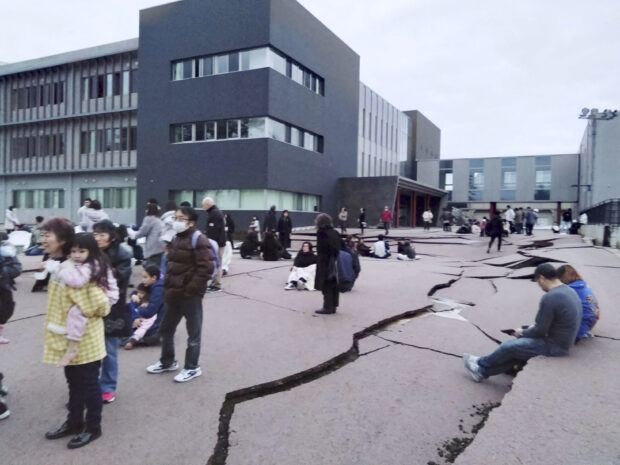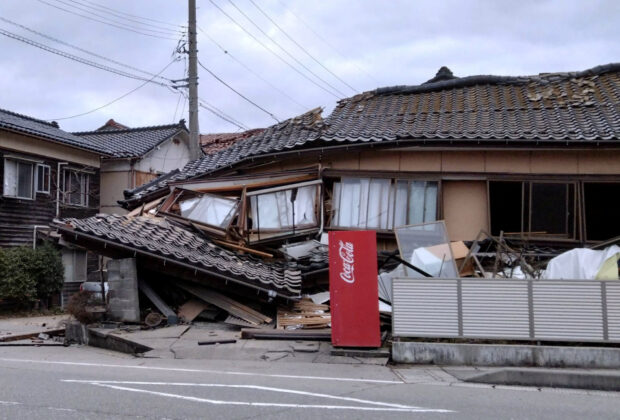Massive earthquake jolts Japan, residents rush to evacuate coast

Road cracks caused by an earthquake is seen in Wajima, Ishikawa prefecture, Japan January 1, 2024, in this photo released by Kyodo. Kyodo via REUTERS
TOKYO — A powerful earthquake struck central Japan on Monday, triggering warnings for residents to evacuate some coastal areas, knocking out power to thousands of homes and disrupting flights and rail services to the affected region.
The quake with a preliminary magnitude of 7.6 triggered waves of around 1 meter along parts of the Sea of Japan coast with a larger wave expected, public broadcaster NHK reported.
The Japan Meteorological Agency has issued tsunami warnings for the coastal prefectures of Ishikawa, Niigata and Toyama, marking the first major warnings since the March 2011 earthquake and tsunami that struck northeastern Japan.
A major tsunami warning means there is a possibility of waves of more than 3 meters (yards).
Article continues after this advertisementRussia also issued tsunami warnings in its far eastern cities of Vladivostok and Nakhodka.
Article continues after this advertisementAuthorities are assessing the extent of any damage and residents need to prepare for any more tremors, Prime Minister Fumio Kishida said in comments aired on NHK.
“Residents need to stay on alert for further possible quakes and I urge people in areas where tsunamis are expected to evacuate as soon as possible,” Kishida said.
“Run!” flashed a bright yellow warning aired on NHK advising residents in specific areas of the coast to immediately evacuate their homes.
LIVE UPDATES: Japan Earthquake on January 1, 2024
Footage by the broadcaster showed a building collapsing in a plume of dust in the coastal city of Suzu and residents in Kanazawa city cowering under tables as tremors shook their home. The quake jolted buildings in the capital Tokyo on the opposite coast.
More than 36,000 households had lost power in Ishikawa and Toyama prefectures, utilities provider Hokuriku Electric Power said.
High speed rail services to Ishikawa have been suspended while telecom operators Softbank and KDDI reported phone and internet service disruptions in Ishikawa and Niigata, according to their websites.
Japanese airline ANA turned back four planes midair as they headed to airports in Toyama and Ishikawa, while Japan Airlines cancelled most of the flight services to Niigata and Ishikawa regions for the rest of the day, according to TV Asahi.
Nuclear plants
Japan’s Nuclear Regulation Authority said no irregularities have been confirmed at nuclear power plants along the Sea of Japan, including five active reactors at Kansai Electric Power’s Ohi and Takahama plants in Fukui Prefecture.
Hokuriku’s Shika plant in Ishikawa, the closest nuclear power station to the quake’s epicenter, had already halted its two reactors before the quake for regular inspections and saw no impact from the quake, the agency said.

A collapsed house following an earthquake is seen in Wajima, Ishikawa prefecture, Japan January 1, 2024, in this photo released by Kyodo. Kyodo via REUTERS
The 2011 earthquake and tsunami killed nearly 20,000 people and devastated towns and nuclear meltdowns in Fukushima.
Another quake, known as the Great Hanshin Earthquake, hit western Japan in 1995, killing more than 6,000 people, mainly in the city of Kobe.
Monday’s quake struck during the Jan. 1 public holiday when millions of Japanese traditionally visit temples to mark the new year.
In Kanazawa, a popular tourist destination in Ishikawa, images showed the remnants of a collapsed torii gate strewn at the entrance of a shrine as anxious worshippers looked on.
Kanazawa resident Ayako Daikai said she had evacuated to a nearby elementary school with her husband and two children soon after the earthquake hit.
“I also experienced the Great Hanshin Earthquake, so I thought it would be safest to evacuate,” she told Reuters when contacted by telephone. The upper floors of the four-story school had filled with residents, she said.
“We haven’t decided when to return home yet.”
In nearby Wajima, images showed collapsed houses and a huge crack along a concrete road where panicked-looking parents clutched their children.
RELATED STORIES
